Vaccination: Methods, Impact, and Parental Concerns Report
VerifiedAdded on 2022/08/09
|6
|1108
|19
Report
AI Summary
This report provides a comprehensive overview of vaccines, including how they work and the different methods of vaccine production, contrasting traditional and biotechnological approaches. It highlights common vaccinations in the US for babies and their impact over the last century, such as the eradication of smallpox and polio. The report also addresses parental concerns regarding vaccination, exploring the religious, philosophical, and personal reasons behind these concerns. It emphasizes the lack of scientific evidence supporting these worries and underscores the importance of vaccination for preventing deadly diseases, particularly in children. The report concludes by advocating for increased awareness and education about vaccination policies to ensure children receive timely and appropriate vaccinations against various diseases.

Vaccination
Running Head: VACCINE 0
Running Head: VACCINE 0
Paraphrase This Document
Need a fresh take? Get an instant paraphrase of this document with our AI Paraphraser
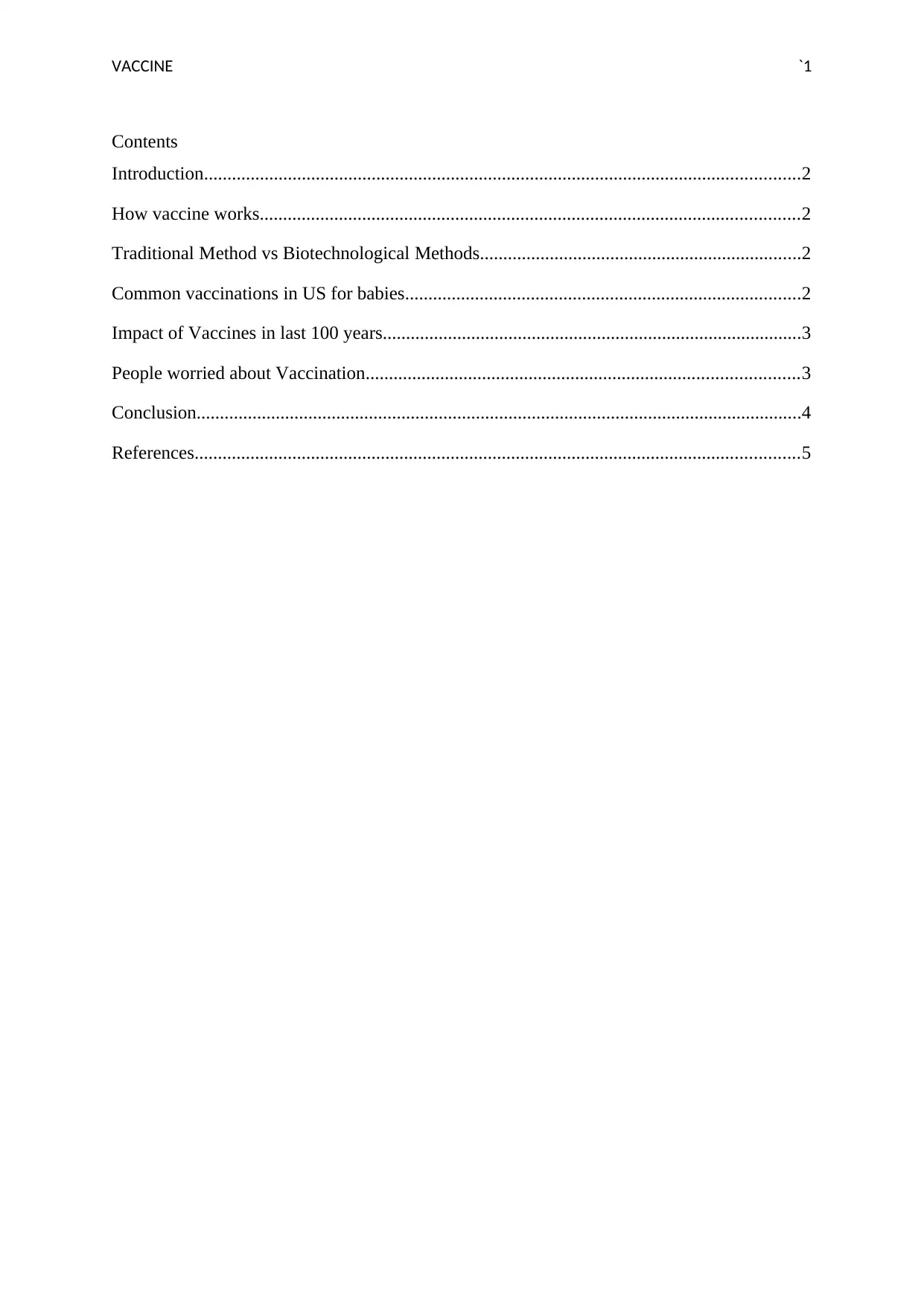
VACCINE `1
Contents
Introduction................................................................................................................................2
How vaccine works....................................................................................................................2
Traditional Method vs Biotechnological Methods.....................................................................2
Common vaccinations in US for babies.....................................................................................2
Impact of Vaccines in last 100 years..........................................................................................3
People worried about Vaccination.............................................................................................3
Conclusion..................................................................................................................................4
References..................................................................................................................................5
Contents
Introduction................................................................................................................................2
How vaccine works....................................................................................................................2
Traditional Method vs Biotechnological Methods.....................................................................2
Common vaccinations in US for babies.....................................................................................2
Impact of Vaccines in last 100 years..........................................................................................3
People worried about Vaccination.............................................................................................3
Conclusion..................................................................................................................................4
References..................................................................................................................................5
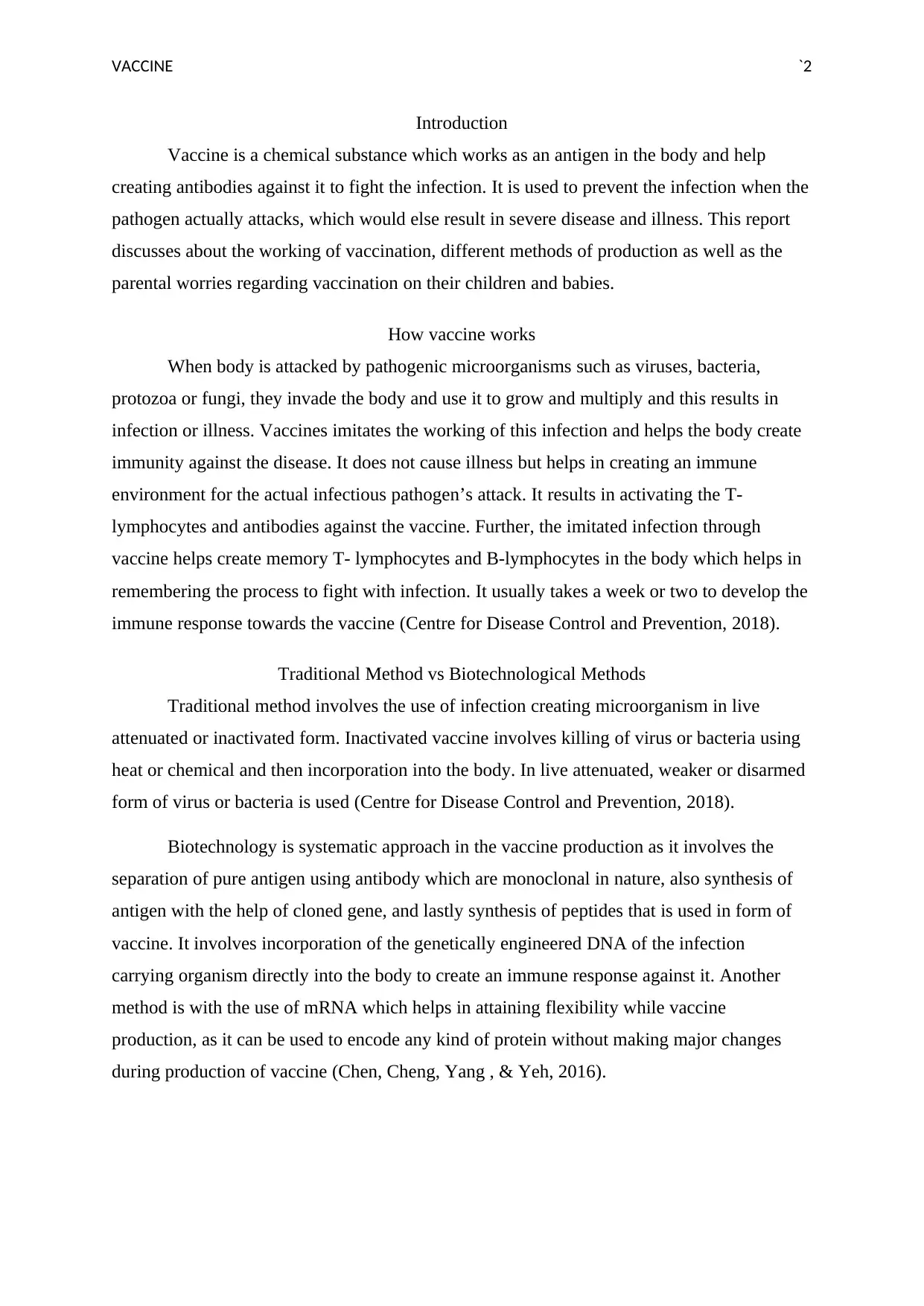
VACCINE `2
Introduction
Vaccine is a chemical substance which works as an antigen in the body and help
creating antibodies against it to fight the infection. It is used to prevent the infection when the
pathogen actually attacks, which would else result in severe disease and illness. This report
discusses about the working of vaccination, different methods of production as well as the
parental worries regarding vaccination on their children and babies.
How vaccine works
When body is attacked by pathogenic microorganisms such as viruses, bacteria,
protozoa or fungi, they invade the body and use it to grow and multiply and this results in
infection or illness. Vaccines imitates the working of this infection and helps the body create
immunity against the disease. It does not cause illness but helps in creating an immune
environment for the actual infectious pathogen’s attack. It results in activating the T-
lymphocytes and antibodies against the vaccine. Further, the imitated infection through
vaccine helps create memory T- lymphocytes and B-lymphocytes in the body which helps in
remembering the process to fight with infection. It usually takes a week or two to develop the
immune response towards the vaccine (Centre for Disease Control and Prevention, 2018).
Traditional Method vs Biotechnological Methods
Traditional method involves the use of infection creating microorganism in live
attenuated or inactivated form. Inactivated vaccine involves killing of virus or bacteria using
heat or chemical and then incorporation into the body. In live attenuated, weaker or disarmed
form of virus or bacteria is used (Centre for Disease Control and Prevention, 2018).
Biotechnology is systematic approach in the vaccine production as it involves the
separation of pure antigen using antibody which are monoclonal in nature, also synthesis of
antigen with the help of cloned gene, and lastly synthesis of peptides that is used in form of
vaccine. It involves incorporation of the genetically engineered DNA of the infection
carrying organism directly into the body to create an immune response against it. Another
method is with the use of mRNA which helps in attaining flexibility while vaccine
production, as it can be used to encode any kind of protein without making major changes
during production of vaccine (Chen, Cheng, Yang , & Yeh, 2016).
Introduction
Vaccine is a chemical substance which works as an antigen in the body and help
creating antibodies against it to fight the infection. It is used to prevent the infection when the
pathogen actually attacks, which would else result in severe disease and illness. This report
discusses about the working of vaccination, different methods of production as well as the
parental worries regarding vaccination on their children and babies.
How vaccine works
When body is attacked by pathogenic microorganisms such as viruses, bacteria,
protozoa or fungi, they invade the body and use it to grow and multiply and this results in
infection or illness. Vaccines imitates the working of this infection and helps the body create
immunity against the disease. It does not cause illness but helps in creating an immune
environment for the actual infectious pathogen’s attack. It results in activating the T-
lymphocytes and antibodies against the vaccine. Further, the imitated infection through
vaccine helps create memory T- lymphocytes and B-lymphocytes in the body which helps in
remembering the process to fight with infection. It usually takes a week or two to develop the
immune response towards the vaccine (Centre for Disease Control and Prevention, 2018).
Traditional Method vs Biotechnological Methods
Traditional method involves the use of infection creating microorganism in live
attenuated or inactivated form. Inactivated vaccine involves killing of virus or bacteria using
heat or chemical and then incorporation into the body. In live attenuated, weaker or disarmed
form of virus or bacteria is used (Centre for Disease Control and Prevention, 2018).
Biotechnology is systematic approach in the vaccine production as it involves the
separation of pure antigen using antibody which are monoclonal in nature, also synthesis of
antigen with the help of cloned gene, and lastly synthesis of peptides that is used in form of
vaccine. It involves incorporation of the genetically engineered DNA of the infection
carrying organism directly into the body to create an immune response against it. Another
method is with the use of mRNA which helps in attaining flexibility while vaccine
production, as it can be used to encode any kind of protein without making major changes
during production of vaccine (Chen, Cheng, Yang , & Yeh, 2016).
⊘ This is a preview!⊘
Do you want full access?
Subscribe today to unlock all pages.

Trusted by 1+ million students worldwide
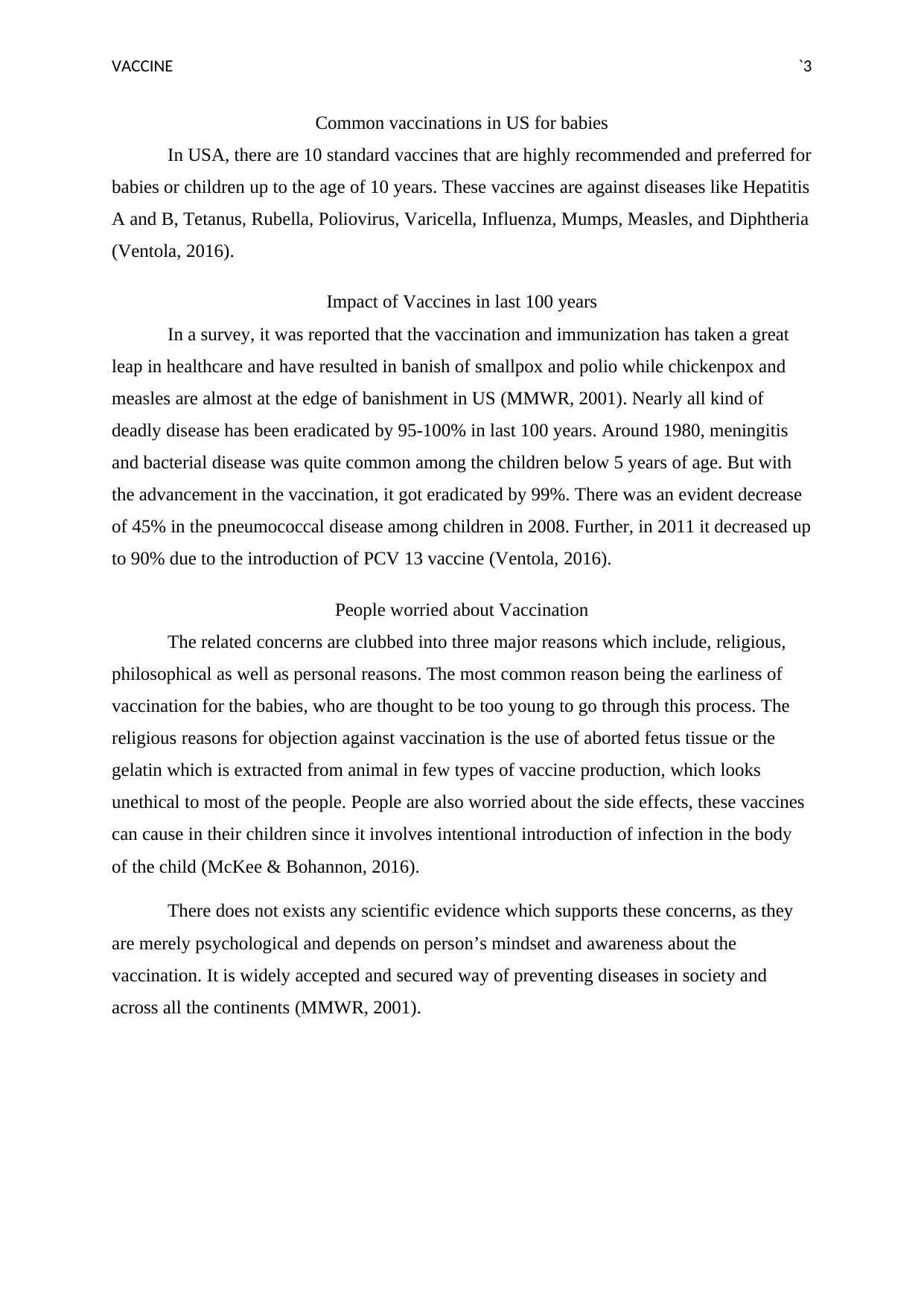
VACCINE `3
Common vaccinations in US for babies
In USA, there are 10 standard vaccines that are highly recommended and preferred for
babies or children up to the age of 10 years. These vaccines are against diseases like Hepatitis
A and B, Tetanus, Rubella, Poliovirus, Varicella, Influenza, Mumps, Measles, and Diphtheria
(Ventola, 2016).
Impact of Vaccines in last 100 years
In a survey, it was reported that the vaccination and immunization has taken a great
leap in healthcare and have resulted in banish of smallpox and polio while chickenpox and
measles are almost at the edge of banishment in US (MMWR, 2001). Nearly all kind of
deadly disease has been eradicated by 95-100% in last 100 years. Around 1980, meningitis
and bacterial disease was quite common among the children below 5 years of age. But with
the advancement in the vaccination, it got eradicated by 99%. There was an evident decrease
of 45% in the pneumococcal disease among children in 2008. Further, in 2011 it decreased up
to 90% due to the introduction of PCV 13 vaccine (Ventola, 2016).
People worried about Vaccination
The related concerns are clubbed into three major reasons which include, religious,
philosophical as well as personal reasons. The most common reason being the earliness of
vaccination for the babies, who are thought to be too young to go through this process. The
religious reasons for objection against vaccination is the use of aborted fetus tissue or the
gelatin which is extracted from animal in few types of vaccine production, which looks
unethical to most of the people. People are also worried about the side effects, these vaccines
can cause in their children since it involves intentional introduction of infection in the body
of the child (McKee & Bohannon, 2016).
There does not exists any scientific evidence which supports these concerns, as they
are merely psychological and depends on person’s mindset and awareness about the
vaccination. It is widely accepted and secured way of preventing diseases in society and
across all the continents (MMWR, 2001).
Common vaccinations in US for babies
In USA, there are 10 standard vaccines that are highly recommended and preferred for
babies or children up to the age of 10 years. These vaccines are against diseases like Hepatitis
A and B, Tetanus, Rubella, Poliovirus, Varicella, Influenza, Mumps, Measles, and Diphtheria
(Ventola, 2016).
Impact of Vaccines in last 100 years
In a survey, it was reported that the vaccination and immunization has taken a great
leap in healthcare and have resulted in banish of smallpox and polio while chickenpox and
measles are almost at the edge of banishment in US (MMWR, 2001). Nearly all kind of
deadly disease has been eradicated by 95-100% in last 100 years. Around 1980, meningitis
and bacterial disease was quite common among the children below 5 years of age. But with
the advancement in the vaccination, it got eradicated by 99%. There was an evident decrease
of 45% in the pneumococcal disease among children in 2008. Further, in 2011 it decreased up
to 90% due to the introduction of PCV 13 vaccine (Ventola, 2016).
People worried about Vaccination
The related concerns are clubbed into three major reasons which include, religious,
philosophical as well as personal reasons. The most common reason being the earliness of
vaccination for the babies, who are thought to be too young to go through this process. The
religious reasons for objection against vaccination is the use of aborted fetus tissue or the
gelatin which is extracted from animal in few types of vaccine production, which looks
unethical to most of the people. People are also worried about the side effects, these vaccines
can cause in their children since it involves intentional introduction of infection in the body
of the child (McKee & Bohannon, 2016).
There does not exists any scientific evidence which supports these concerns, as they
are merely psychological and depends on person’s mindset and awareness about the
vaccination. It is widely accepted and secured way of preventing diseases in society and
across all the continents (MMWR, 2001).
Paraphrase This Document
Need a fresh take? Get an instant paraphrase of this document with our AI Paraphraser
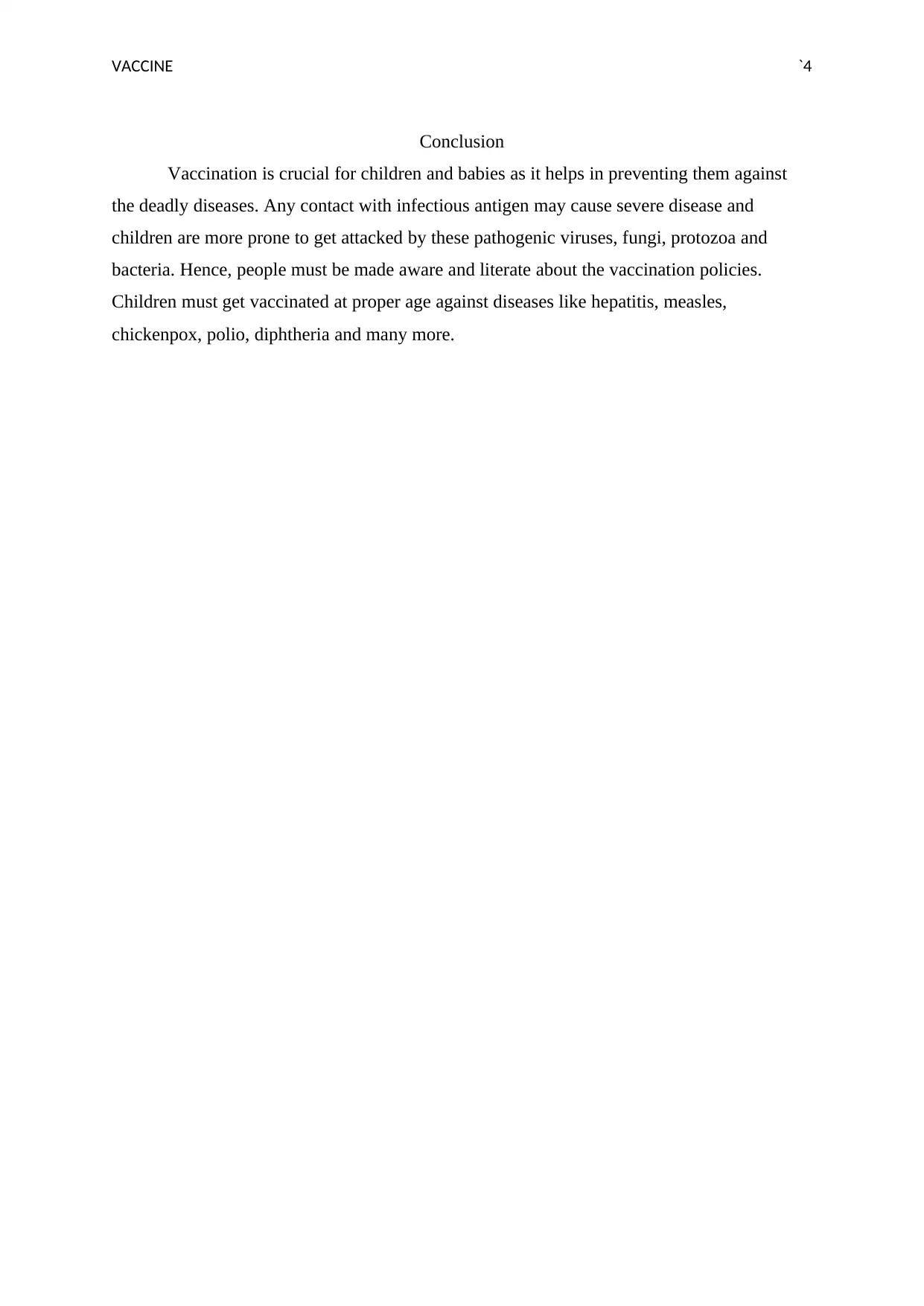
VACCINE `4
Conclusion
Vaccination is crucial for children and babies as it helps in preventing them against
the deadly diseases. Any contact with infectious antigen may cause severe disease and
children are more prone to get attacked by these pathogenic viruses, fungi, protozoa and
bacteria. Hence, people must be made aware and literate about the vaccination policies.
Children must get vaccinated at proper age against diseases like hepatitis, measles,
chickenpox, polio, diphtheria and many more.
Conclusion
Vaccination is crucial for children and babies as it helps in preventing them against
the deadly diseases. Any contact with infectious antigen may cause severe disease and
children are more prone to get attacked by these pathogenic viruses, fungi, protozoa and
bacteria. Hence, people must be made aware and literate about the vaccination policies.
Children must get vaccinated at proper age against diseases like hepatitis, measles,
chickenpox, polio, diphtheria and many more.
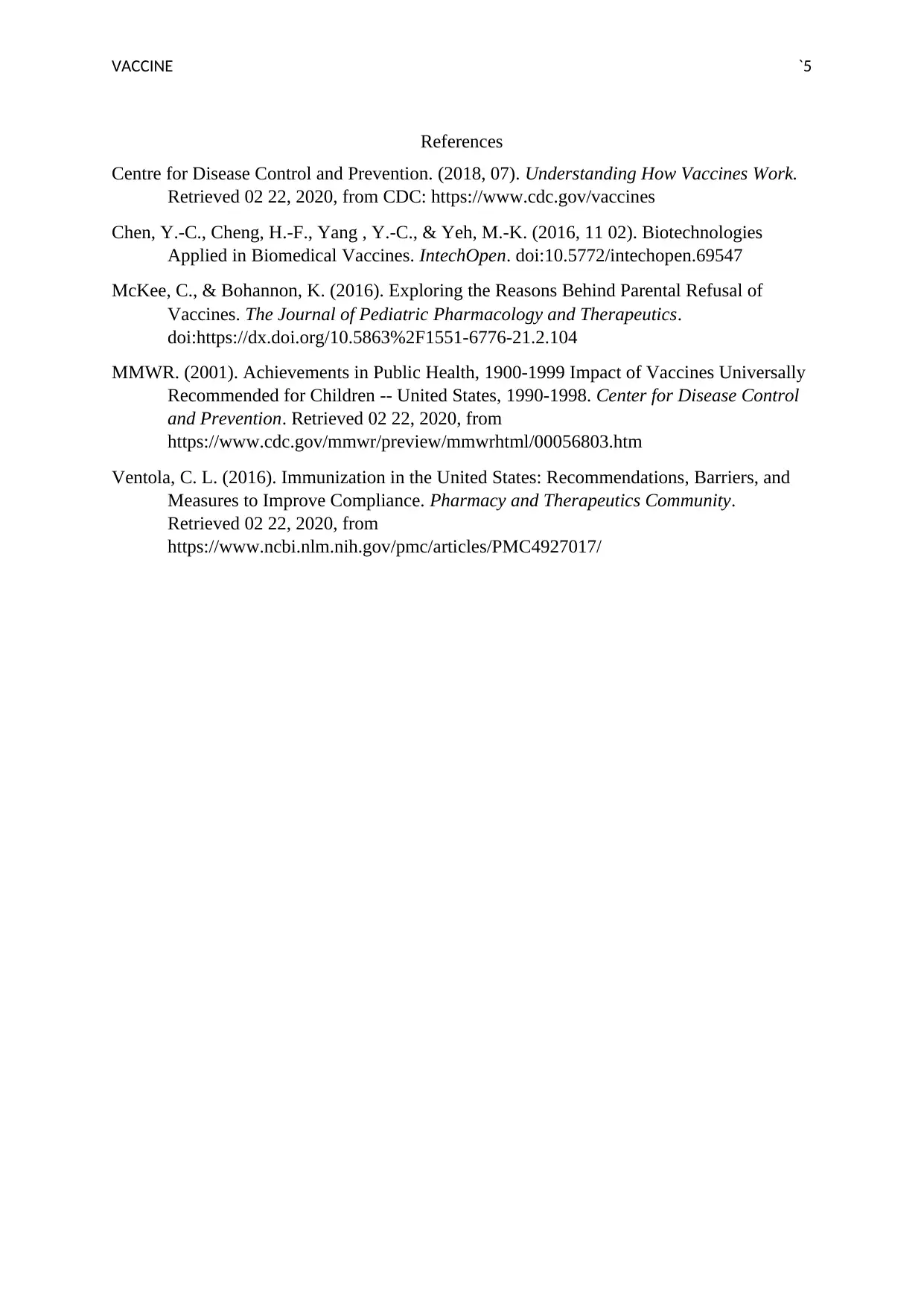
VACCINE `5
References
Centre for Disease Control and Prevention. (2018, 07). Understanding How Vaccines Work.
Retrieved 02 22, 2020, from CDC: https://www.cdc.gov/vaccines
Chen, Y.‐C., Cheng, H.‐F., Yang , Y.‐C., & Yeh, M.‐K. (2016, 11 02). Biotechnologies
Applied in Biomedical Vaccines. IntechOpen. doi:10.5772/intechopen.69547
McKee, C., & Bohannon, K. (2016). Exploring the Reasons Behind Parental Refusal of
Vaccines. The Journal of Pediatric Pharmacology and Therapeutics.
doi:https://dx.doi.org/10.5863%2F1551-6776-21.2.104
MMWR. (2001). Achievements in Public Health, 1900-1999 Impact of Vaccines Universally
Recommended for Children -- United States, 1990-1998. Center for Disease Control
and Prevention. Retrieved 02 22, 2020, from
https://www.cdc.gov/mmwr/preview/mmwrhtml/00056803.htm
Ventola, C. L. (2016). Immunization in the United States: Recommendations, Barriers, and
Measures to Improve Compliance. Pharmacy and Therapeutics Community.
Retrieved 02 22, 2020, from
https://www.ncbi.nlm.nih.gov/pmc/articles/PMC4927017/
References
Centre for Disease Control and Prevention. (2018, 07). Understanding How Vaccines Work.
Retrieved 02 22, 2020, from CDC: https://www.cdc.gov/vaccines
Chen, Y.‐C., Cheng, H.‐F., Yang , Y.‐C., & Yeh, M.‐K. (2016, 11 02). Biotechnologies
Applied in Biomedical Vaccines. IntechOpen. doi:10.5772/intechopen.69547
McKee, C., & Bohannon, K. (2016). Exploring the Reasons Behind Parental Refusal of
Vaccines. The Journal of Pediatric Pharmacology and Therapeutics.
doi:https://dx.doi.org/10.5863%2F1551-6776-21.2.104
MMWR. (2001). Achievements in Public Health, 1900-1999 Impact of Vaccines Universally
Recommended for Children -- United States, 1990-1998. Center for Disease Control
and Prevention. Retrieved 02 22, 2020, from
https://www.cdc.gov/mmwr/preview/mmwrhtml/00056803.htm
Ventola, C. L. (2016). Immunization in the United States: Recommendations, Barriers, and
Measures to Improve Compliance. Pharmacy and Therapeutics Community.
Retrieved 02 22, 2020, from
https://www.ncbi.nlm.nih.gov/pmc/articles/PMC4927017/
⊘ This is a preview!⊘
Do you want full access?
Subscribe today to unlock all pages.

Trusted by 1+ million students worldwide
1 out of 6
Related Documents
Your All-in-One AI-Powered Toolkit for Academic Success.
+13062052269
info@desklib.com
Available 24*7 on WhatsApp / Email
![[object Object]](/_next/static/media/star-bottom.7253800d.svg)
Unlock your academic potential
Copyright © 2020–2025 A2Z Services. All Rights Reserved. Developed and managed by ZUCOL.





